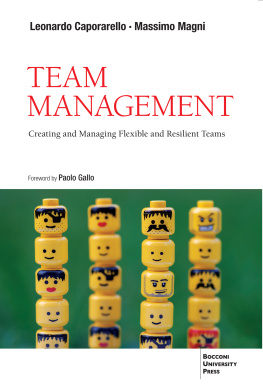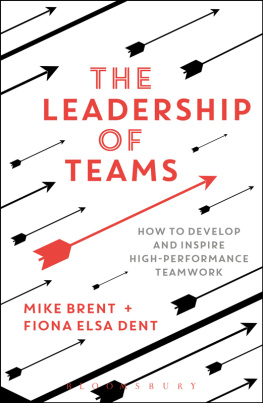COLLABORATIVE INTELLIGENCE
COLLABORATIVE INTELLIGENCE
Using Teams to Solve Hard Problems
J. RICHARD HACKMAN

Collaborative Intelligence
Copyright 2011 by J. Richard Hackman
All rights reserved. No part of this publication may be reproduced, distributed, or transmitted in any form or by any means, including photocopying, recording, or other electronic or mechanical methods, without the prior written permission of the publisher, except in the case of brief quotations embodied in critical reviews and certain other noncommercial uses permitted by copyright law. For permission requests, write to the publisher, addressed Attention: Permissions Coordinator, at the address below.

| Berrett-Koehler Publishers, Inc.
235 Montgomery Street, Suite 650
San Francisco, California 94104-2916
Tel: (415) 288-0260, Fax: (415) 362-2512
www.bkconnection.com |
Ordering information for print editions
Quantity sales. Special discounts are available on quantity purchases by corporations, associations, and others. For details, contact the Special Sales Department at the Berrett-Koehler address above.
Individual sales. Berrett-Koehler publications are available through most bookstores. They can also be ordered directly from Berrett-Koehler: Tel: (800) 929-2929; Fax: (802) 8647626; www.bkconnection.com
Orders for college textbook/course adoption use. Please contact Berrett-Koehler:
Tel: (800) 929-2929; Fax: (802) 864-7626.
Orders by U.S. trade bookstores and wholesalers. Please contact Ingram Publisher Services, Tel: (800) 509-4887; Fax: (800) 838-1149; E-mail: customer.service@ingram publisherservices.com; or visit www.ingrampublisherservices.com/Ordering for details about electronic ordering.
Berrett-Koehler and the BK logo are registered trademarks of Berrett-Koehler Publishers, Inc.
First Edition
Hardcover print edition ISBN 978-1-60509-990-3
PDF e-book ISBN 978-1-60509-991-0
IDPF e-book ISBN 978-1-60509-992-7
2011-1
Book producer and text designer: BookMatters, Berkeley, CA
Copyeditor: Hope Steele
Proofer: Janet Reed Blake
Indexer: Leonard Rosenbaum
Cover designer: Ian Shimkoviak/The Book Designers
For Fred Ambrose
CONTENTS
PREFACE
It was not an altogether comfortable meeting. My colleagues and I were huddled with our government sponsor to review progress on what we had come to call the Group Brain research project. We had completed a number of studies that explored some provocative parallels between brains (which are systems of interdependent neural modules) and groups (which are systems of interdependent members). The findings so far were intriguing, but we had not yet found a way to bring what we were learning to bear on the problem that most interested our sponsornamely, how best to design and lead the diversity of teams that operate within the U.S. intelligence community.
Then Stephen Kosslyn, a cognitive neuroscientist and co-principal investigator on the Group Brain project, had an idea: What if Richard wrote a short book that would draw out the implications of our findings specifically for intelligence teams? he asked. He went on to point out that it could easily be completed within a year and then distributed widely throughout the community. It would be just what we neededa bridge between scholarly research and leadership practice. Our sponsor thought that was a splendid idea, and everyone looked forward to reading what I would write.
That was four years ago. Writing the book became a rather more involved and interesting undertaking than any of us had imagined, as both the range of teams discussed and the books intended audience expanded considerably. For example, the book now incorporates material about other kinds of teamssuch as athletic teams, flight-deck crews, healthcare teams, and even musical ensembleswhose work, like that of intelligence teams, can be far from routine. So what started as a short set of research-based guidelines for the intelligence community evolved into a book that also draws lessons from the intelligence communityspecifically for those who lead or serve on any team that has to deal with hard problems in a challenging context.
Who the Book Is For
The book was written with intelligence, defense, crisis management, and law enforcement readers in mind, including both experienced and novice team leaders and members. Although this is not a textbook, instructors in national security and law enforcement training organizations will find here material that may be useful in their courses. The book also should be informative to readers who create, lead, or serve on decision-making, production, or service teams in government, the private sector, or nonprofit enterprises. Finally, I hope the book will be of interest to general readers who would like to learn a little about the backstage of collaboration in the intelligence and national security communities.
This book therefore can be viewed as a follow-on to my earlier book, Leading Teams, which was published almost a decade ago. A great deal of research on teams has been done since then, and the findings from that research are incorporated here. Recent studies have shown, for example, that the context within which a work team operates is enormously consequential for team behavior and performance. The intelligence community assuredly provides a unique (and often challenging) context for teamwork, and this book gives special attention to what is needed for teams to thrive in such contexts.
I have tried to create a book that will be as interesting and accessible to non-technical readers as it is to those who have experience and expertise working with teams. Although my main aspiration has been to provide guidance that will be useful to team leaders and members, there are no one minute prescriptions herecreating, leading, and serving on teams is not that simple. But neither are there excursions into the kinds of arcane theoretical issues that are of interest only to those of us whose day jobs involve intense study of individual and group dynamics. That is a narrow beam on which to balance, and I have tried hard not to fall off in either direction.
Keeping Secrets
No individual is identified by name in the book, except those whose remarks are on the record or for which it is possible to cite a publicly available source. Nor do I identify by name either specific teams or specific organizational units. If I were to provide more details than I do, then some insiders might be able figure out who and what I am describing. That general problem with research confidentiality is especially salient here since the readers of this book will include people who make their living drawing conclusions from sketchy data.
It has been necessary, therefore, to disguise some individuals, settings, and events. My intent has been to alter only details that are of no consequence for the interpretation of the material, but that is a judgment call, and I occasionally may have unknowingly changed something that actually is significant. Readers can be assured, however, that I have taken care never to offer up what my late colleague Brendan Maher liked to call an Irish Truth: Something that, although not actually true, is required to sustain the narrative.
Next page









